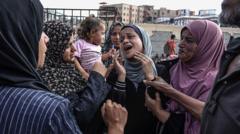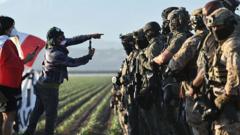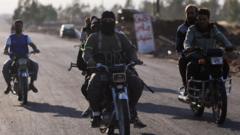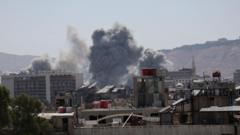The Gaza Health Ministry reported that Israeli forces killed at least 32 individuals near a humanitarian assistance location on Saturday, adding to a growing toll of over 670 Palestinians since the introduction of a controversial aid system by Israel.
Gaza Violence Escalates as Israeli Military Strikes Near Aid Distribution Points

Gaza Violence Escalates as Israeli Military Strikes Near Aid Distribution Points
Recent attacks result in rising death toll among Palestinians, intensifying scrutiny of Israel's new food distribution system in Gaza.
In a deadly clash in southern Gaza, the Gaza Health Ministry stated on Saturday that Israeli military action claimed at least 32 lives. According to Palestinian media sources, Israeli troops opened fire near a food distribution site linked to the Gaza Humanitarian Foundation, an organization backed by Israel. The Nasser Medical Complex, the main hospital in southern Gaza, confirmed receiving 29 bodies from the aid distribution points but did not specify the circumstances of their deaths or the whereabouts of additional casualties.
This incident appears to be entwined with a newly implemented food distribution method that Israel rolled out nearly two months ago, a system that has sparked significant controversy and violence. The United Nations reported this week that over 670 Palestinians have been killed near sites established under this initiative since its late May launch. Israel’s military has been directing the Gaza Humanitarian Foundation to manage food distribution at select locations within areas it controls, superseding a previously broader operation run by the U.N. This shift was prompted by concerns that Hamas was exploiting food supplies for its benefit, but critics argue that the new setup creates perilous situations for civilians seeking assistance, leading to clashes with Israeli troops.
Humanitarian organizations argue that the process for obtaining food has become a perilous endeavor, often resulting in deadly encounters with Israeli forces. Reports indicate that Israeli soldiers have frequently fired on groups of Palestinians approaching these aid sites, which many see as a brutal method of controlling large crowds of desperate residents. While Israeli officials admit that troops have engaged crowds, they contest that casualty figures may have been exaggerated. The Gaza Humanitarian Foundation contends that substantial violence is rare at these distribution points and suggests Hamas has incited unrest and targeted employees at the sites.
Despite the new distribution system's intent to mitigate food shortages, aid organizations assert that hunger in Gaza remains pervasive, exacerbated by the extensive blockade imposed by Israel between March and May. The United Nations Relief and Works Agency (UNRWA) reported this week that during screenings conducted in late June, over 900 children, nearly 10% of those assessed, were found to be suffering from malnutrition.
The ongoing cycle of violence and the humanitarian crisis in Gaza have drawn international scrutiny and raised urgent questions about the efficacy and moral implications of Israel's newly adopted aid distribution strategy.
This incident appears to be entwined with a newly implemented food distribution method that Israel rolled out nearly two months ago, a system that has sparked significant controversy and violence. The United Nations reported this week that over 670 Palestinians have been killed near sites established under this initiative since its late May launch. Israel’s military has been directing the Gaza Humanitarian Foundation to manage food distribution at select locations within areas it controls, superseding a previously broader operation run by the U.N. This shift was prompted by concerns that Hamas was exploiting food supplies for its benefit, but critics argue that the new setup creates perilous situations for civilians seeking assistance, leading to clashes with Israeli troops.
Humanitarian organizations argue that the process for obtaining food has become a perilous endeavor, often resulting in deadly encounters with Israeli forces. Reports indicate that Israeli soldiers have frequently fired on groups of Palestinians approaching these aid sites, which many see as a brutal method of controlling large crowds of desperate residents. While Israeli officials admit that troops have engaged crowds, they contest that casualty figures may have been exaggerated. The Gaza Humanitarian Foundation contends that substantial violence is rare at these distribution points and suggests Hamas has incited unrest and targeted employees at the sites.
Despite the new distribution system's intent to mitigate food shortages, aid organizations assert that hunger in Gaza remains pervasive, exacerbated by the extensive blockade imposed by Israel between March and May. The United Nations Relief and Works Agency (UNRWA) reported this week that during screenings conducted in late June, over 900 children, nearly 10% of those assessed, were found to be suffering from malnutrition.
The ongoing cycle of violence and the humanitarian crisis in Gaza have drawn international scrutiny and raised urgent questions about the efficacy and moral implications of Israel's newly adopted aid distribution strategy.





















